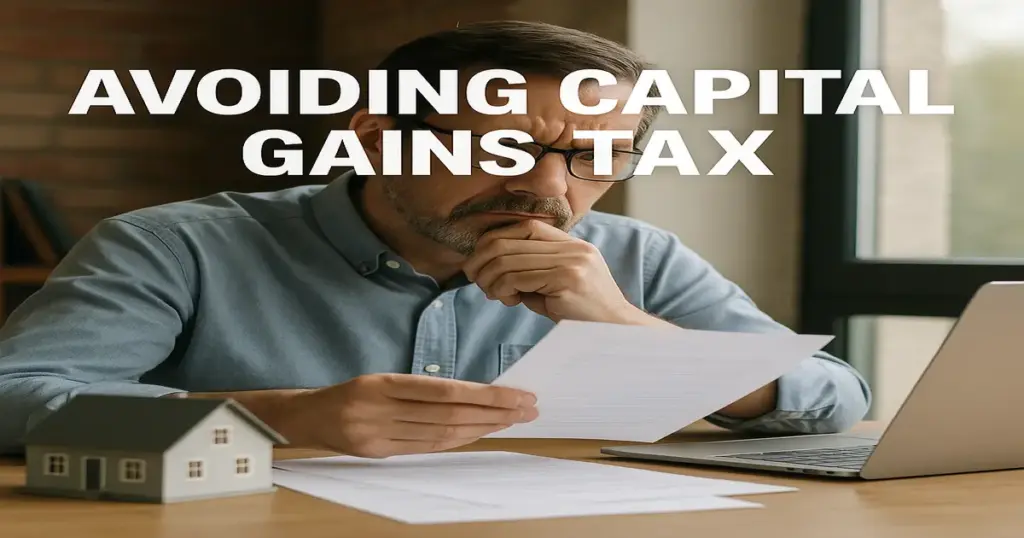How to Avoid Capital Gains Tax When Selling a Buy-to-Let in the UK
Capital gains tax (CGT) can be a significant financial burden for UK landlords when selling a buy-to-let property. With rising property prices and stricter tax regulations, many landlords are now exploring legitimate strategies to avoid or minimise their CGT liabilities.
In this guide, we’ll walk you through how to avoid capital gains tax when selling a buy-to-let in the UK, covering everything from exemptions to clever planning strategies. This article is for you if you’re a landlord looking to sell without a massive tax bill.
What Is Capital Gains Tax (CGT) on Buy-to-Let Properties?
Capital Gains Tax is a tax on the profit when you sell (or “dispose of” an asset that has increased in value. The tax applies to the gain, not the total sale price for buy-to-let properties. For example, if you bought a property for £200,000 and sold it for £300,000, your gain would be £100,000.
Unlike primary residences, buy-to-let properties do not qualify for complete Private Residence Relief, so CGT is very much in play for landlords.
Current CGT Rates for Buy-to-Let Properties
As of the 2024/25 tax year, the CGT rates for resident Property are:
18% on gains within the basic income tax band
24% on gains above the basic rate threshold (reduced from the previous 28% in 2024)
Everyone also has a CGT annual exempt allowance, which was £6,000 for the 2023/24 tax year and is now £3,000 for 2024/25. You only pay tax on the gains above this amount.
Why Avoiding Capital Gains Tax Matters for Landlords
With property values appreciating over time, it’s not uncommon for landlords to face six-figure capital gains. That’s why CGT is a key driver in landlord sales decisions, whether you’re selling cash out, reinvesting elsewhere, or exiting the market altogether, understanding how to reduce or avoid CGT legally can save you tens of thousands of pounds.
How to Avoid or Reduce Capital Gains Tax on a Buy-to-Let Property
Let’s explore the most effective and legitimate ways landlords can avoid or minimise capital gains tax in the UK.
Utilise the CGT Annual Exemption
Every individual has a CGT allowance—currently £3,000 per year. If you co-own properties with your spouse or civil partner, you can combine allowances, potentially shielding £6,000 of gain from tax.
Why it works: It’s automatic and legal – no paperwork required, though proper reporting is essential.
TransProTransfer of Propertyouse or Civil Partner
Transfers between spouses and civil partners are exempt from CGT. By transferring a portion (or all) of the Property to your spouse, you can:
Utilise two CGT allowances
Potentially keep gains within the lower tax band
This strategy is beneficial if one partner is a basic-rate taxpayer or has unused allowances.
Why it works: It spreads the gain across two taxpayers, lowering the tax burden.
Deduct Allowable Expenses and Costs
You can reduce your taxable gain by subtracting:
Purchase costs (e.g., stamp duty, legal fees)
Improvement costs (e.g., extensions, new kitchen, not repairs)
Selling costs (e.g., estate agent fees, solicitor fees)
Keep detailed records and receipts to support your claims.
Why it works: These deductions reduce the total taxable gain, potentially dropping you into a lower CGT rate band.
Use Private Residence Relief (PRR) and Letting Relief
If the buy-to-rent was ever your primary residence, you may qualify for Private Residence Relief for the time you lived there, plus an additional final 9 months.
You may also be eligible for Letting Relief if you own a property alongside tenants. However, this Relief was significantly curtailed in 2020, limiting its use.
Why it works: It can substantially reduce or even eliminate CGT if you have lived in the Property for a meaningful period.
Time the Sale Strategically
You could delay a sale until the next tax year if:
You’ve already used up your current CGT allowance
You expect your income to drop, pushing you into the basic-rate band
Selling after 6 April in a lower-income year could save thousands.
Why it works: Timing affects tax bands and allowances, which landlords often overlook.
Gift the Property to Children or Use a Trust
You can gift Property to your children, though this counts as a “disposal “for CGT. However, a trust structure may offer inheritance tax (IHT) and CGT planning opportunities, especially for long-term estate planning.
Trust comes with complex tax implications, so always seek professional advice.
Why it works: Shifting ownership outside your estate could avoid CGT in the long term, especially with careful planning.
Offset Losses Against Gains
Suppose you’ve sold your assets (e.g., shares or other Property) at a loss. In that case, you can offset those losses against property-to-let previous years’ losses, which can be carried forward as long as they were reported to HMRC.
Why it works: Losses lower the taxable gain, reducing the CGT owed.
Incorporate and Use a Limited Company
Selling through a limited company can be more tax-efficient, particularly if you:
Own multiple buy-to-lets
Intend to reinvest profits
Want to benefit from corporation tax rates (currently 19%-25%)
However, transferring properties into a company can trigger stamp duty and CGT, so this strategy is best for early or new acquisitions.
Why it works: A company structure can help retain profits and reinvest tax-efficiently over time.
Use an EIS or SEIS Investment to Defer CGT
By reinvesting the gain into an Enterprise Investment Scheme (EIS) or Seed Enterprise Investment Scheme (SEIS), you can defer the CGT liability – and in some cases, eliminate it after a specific period.
This route carries investment risk, so consider it a part of a broader financial strategy.
Why it works: Government schemes incentivise investment in small businesses by deferring or eliminating CGT.
Seek Professional Tax Planning Advice
Tax rules change frequently. A qualified accountant or tax adviser can:
Help structure a sale for maximum efficiency
Advise on timing and ownership strategies
Avoid costly mistakes or overlooked deductions
Why it works: Tailored advice ensures you’re not paying more tax than necessary.
FAQs: Capital Gains Tax for UK Landlords
Can I avoid CGT entirely when selling my buy-to-let?
Yes, but it depends on your circumstances. Using your annual exemption, spouse transfers, PRR, or EIS reinvestment may allow you to avoid CGT altogether legally.
Do I have to report the sale of my buy-to-let Property?
Yes. You must report and pay any CGT within 60 days of the property transaction; otherwise, you may be penalised.
How is CGT calculated on a buy-to-let property?
It’s based on:
Sale price – purchase price
Minus allowable expenses
Minus annual exemption
Apply either 18% or 24%, depending on your income bracket
Can I avoid CGT by reinvesting in another property?
No. Unlike in the U.S., the UK does not offer “rollover relief” for residential properties. Reinvestment does not defer or eliminate CGT.
Is CGT due if I give Property to children?
Gifting is considered a disposal for CGT purposes, even if no money changes hands. You may still face a tax bill based on the market value.
Do I pay CGT if I inherit a buy-to-let property and then sell it?
You don’t pay CGT on inheritance but may owe CGT on any gain between the value at the time of inheritance and the sale price.
Can I spread the gain across multiple tax years?
Not directly, but with timing and asset structuring (e.g., partial sales, staggered transfers), you can manage when the gain is realised, which may spread the liability.
Final Thoughts
FGT can feel like a heavy financial blow for landlords looking to sell a buy-to-let property, but it doesn’t have to be. You can avoid or significantly reduce your liability with thoughtful planning, timing, and tax-efficient strategies.
The tax landscape offers many tools to reduce one’s burden, from using one’s annual exemption to transferring ownership, offsetting losses, and considering long-term options like trusts or EIS.
Always consult with a tax adviser to tailor the right approach to your specific situation. Good advice usually costs far less than the capital gains tax bill it helps you avoid.
🔗 Official HMRC Resources
Capital Gains Tax: What you pay it on, rates and allowances
https://www.gov.uk/capital-gains-tax
Explains CGT basics, including what assets are taxed, current rates, and your annual tax-free allowance.Report and pay Capital Gains Tax on UK property
https://www.gov.uk/report-and-pay-your-capital-gains-tax
Essential guide on how and when to report CGT within 60 days of completion.Read our top Blogs:
Sell My Property Fast For Cash In Wandsworth
What to Do If Your House Won’t Sell: Fast Solutions That Work
How to Sell House Fast: Proven Tips to Get a Quick Sale Without Estate Agents
Call +447702210159 our friendly team for a same-day offer





